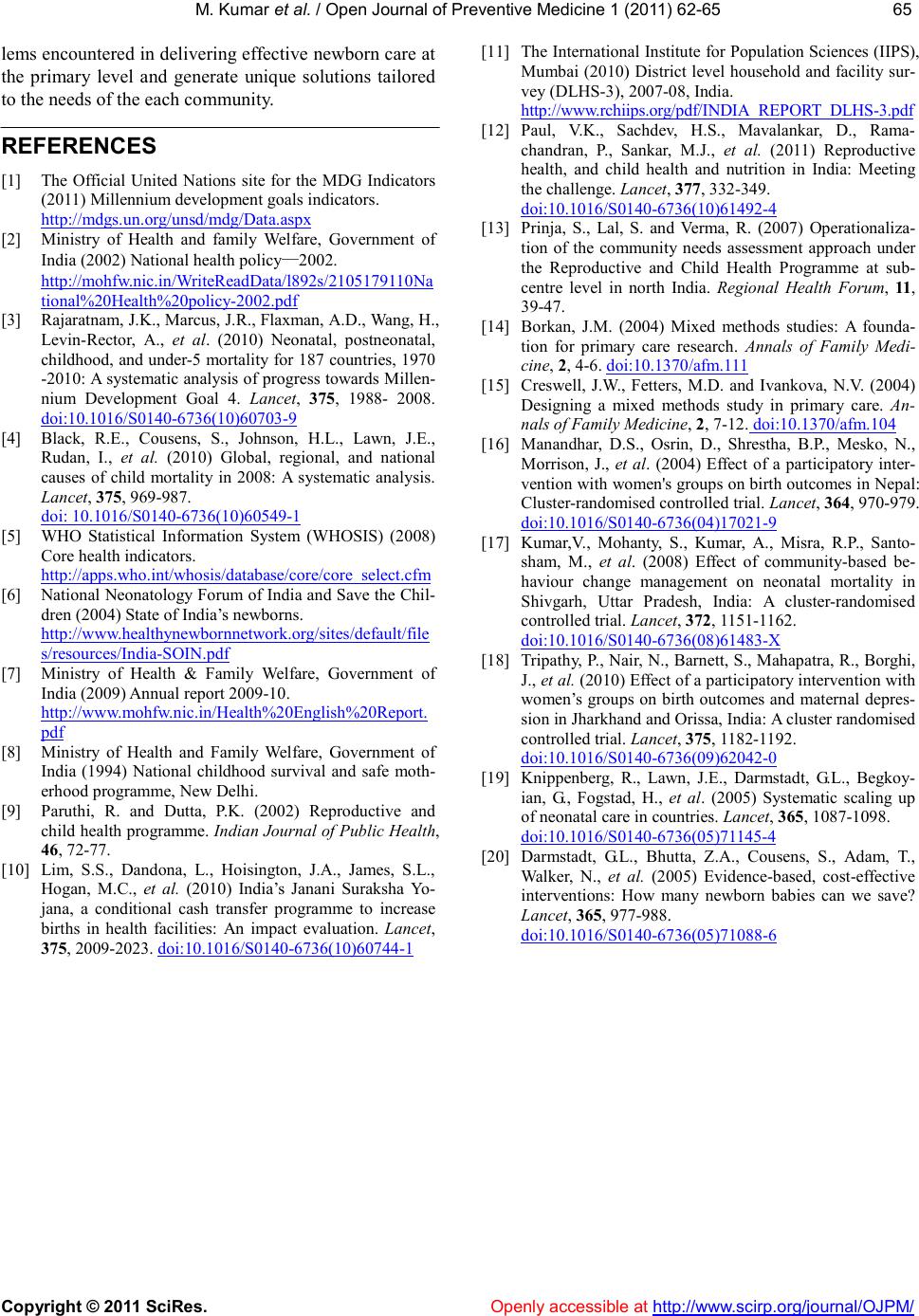
M. Ku mar et al. / Open Journal of Preventive Medicine 1 (2011) 62-65
Copyright © 2011 SciRes. http://www.scirp.org/journal/OJPM/
65
65
[11] The International Institute for Population Sciences (IIPS),
Mumbai (2010) District level household and facility sur-
vey (DLHS-3), 2007-08, India.
http://www.rchiips.org/pdf/INDIA_REPORT_DLHS-3.pdf
lems encountered in delivering effective newborn care at
the primary level and generate unique solutions tailored
to the needs of the each communit y.
[12] Paul, V.K., Sachdev, H.S., Mavalankar, D., Rama-
chandran, P., Sankar, M.J., et al. (2011) Reproductive
health, and child health and nutrition in India: Meeting
the challenge. Lan cet, 377, 332-349.
doi:10.1016/S0140-6736(10)61492-4
REFERENCES
[1] The Official United Nations site for the MDG Indicators
(2011) Millennium development goals indicators.
http://mdgs.un.org/unsd/mdg/Data.aspx [13] Prinja, S., Lal, S. and Verma, R. (2007) Operationaliza-
tion of the community needs assessment approach under
the Reproductive and Child Health Programme at sub-
centre level in north India. Regional Health Forum, 11,
39-47.
[2] Ministry of Health and family Welfare, Government of
India (2002) National health policy—2002.
http://mohfw.nic.in/WriteReadData/l892s/2105179110Na
tional%20Health%20policy-2002.pdf
[3] Rajaratnam, J.K., Marcus, J.R., Flaxman, A.D., Wang, H.,
Levin-Rector, A., et al. (2010) Neonatal, postneonatal,
childhood, and under-5 mortality for 187 countries, 1970
-2010: A systematic analysis of progress towards Millen-
nium Development Goal 4. Lancet, 375, 1988- 2008.
doi:10.1016/S0140-6736(10)60703-9
[14] Borkan, J.M. (2004) Mixed methods studies: A founda-
tion for primary care research. Annals of Family Medi-
cine, 2, 4-6. doi:10.1370/afm.111
[15] Creswell, J.W., Fetters, M.D. and Ivankova, N.V. (2004)
Designing a mixed methods study in primary care. An-
nals of Family Medicine, 2, 7-12. doi:10.1370/af m. 104
[4] Black, R.E., Cousens, S., Johnson, H.L., Lawn, J.E.,
Rudan, I., et al. (2010) Global, regional, and national
causes of child mortality in 2008: A systematic analysis.
Lan cet, 375, 969-987 .
doi: 10.1016/S0140-6736(10)60549-1
[16] Manandhar, D.S., Osrin, D., Shrestha, B.P., Mesko, N.,
Morrison, J., et al. (2004) Effect of a participatory inter-
vention with women's groups on birth outcomes in Nepal:
Cluster-randomised controlled trial. Lancet, 364, 97 0-979.
doi:10.1016/S0140-6736(04)17021-9
[5] WHO Statistical Information System (WHOSIS) (2008)
Core health indicators.
http://apps.who.int/whosis/database/core/core_select.cfm
[17] Kumar,V., Mohanty, S., Kumar, A., Misra, R.P., Santo-
sham, M., et al. (2008) Effect of community-based be-
haviour change management on neonatal mortality in
Shivgarh, Uttar Pradesh, India: A cluster-randomised
controlled trial. Lancet, 372, 1151-1162.
doi:10.1016/S0140-6736(08)61483-X
[6] National Neonatology Forum of India and Save the Chil-
dren (2004) State of India’s newborns.
http://www.healthynewbornnetwork.org/sites/default/file
s/resources/India-SOIN.pdf [18] Trip athy, P., Nair, N. , Barnet t, S., Mah apatr a, R., Bo rghi,
J., et al . (2010) Effect of a participatory intervention with
women’s groups on birth outcomes and maternal depres-
sion in Jharkhand and Orissa, India: A cluster randomised
controlled trial. Lancet, 375, 1182-1192.
doi:10.1016/S0140-6736(09)62042-0
[7] Ministry of Health & Family Welfare, Government of
India (2009) Annual report 2009-10.
http://www.mohfw.nic.in/Health%20English%20Report.
pdf
[8] Ministry of Health and Family Welfare, Government of
India (1994) National childhood survival and safe moth-
erhood programme, New Delhi. [19] Knippenberg, R., Lawn, J.E., Darmstadt, G.L., Begkoy-
ian, G., Fogstad, H., et al. (2005) Systematic scaling up
of neonatal care in countries. Lancet, 365, 1087- 10 98.
doi:10.1016/S0140-6736(05)71145-4
[9] Paruthi, R. and Dutta, P.K. (2002) Reproductive and
child health p rogramme. Indian Journal of Public Health,
46, 72-7 7. [20] Darmstadt, G.L., Bhutta, Z.A., Cousens, S., Adam, T.,
Walker, N., et al. (2005) Evidence-based, cost-effective
interventions: How many newborn babies can we save?
Lan cet, 365, 977-988 .
doi:10.1016/S0140-6736(05)71088-6
[10] Lim, S.S., Dandona, L., Hoisington, J.A., James, S.L.,
Hogan, M.C., et al. (2010) India’s Janani Suraksha Yo-
jana, a conditional cash transfer programme to increase
births in health facilities: An impact evaluation. Lancet,
375, 2009- 2023. doi:10.1016/S0140-6736(10)60744-1
Openly accessible at